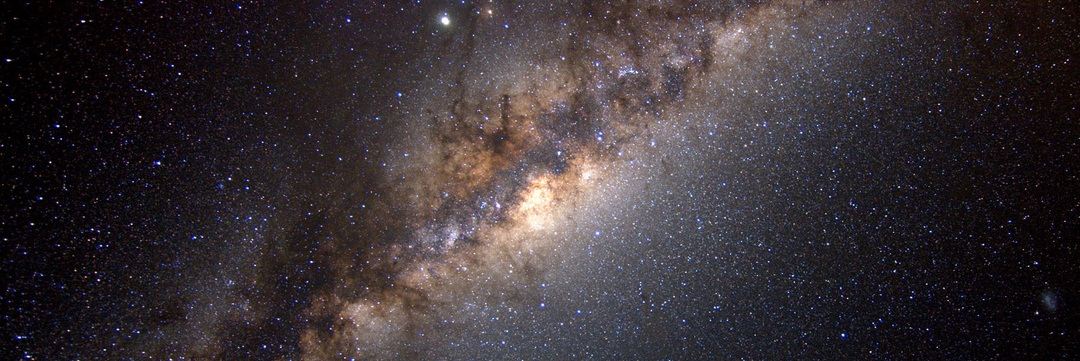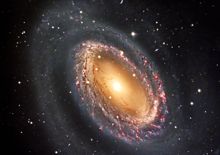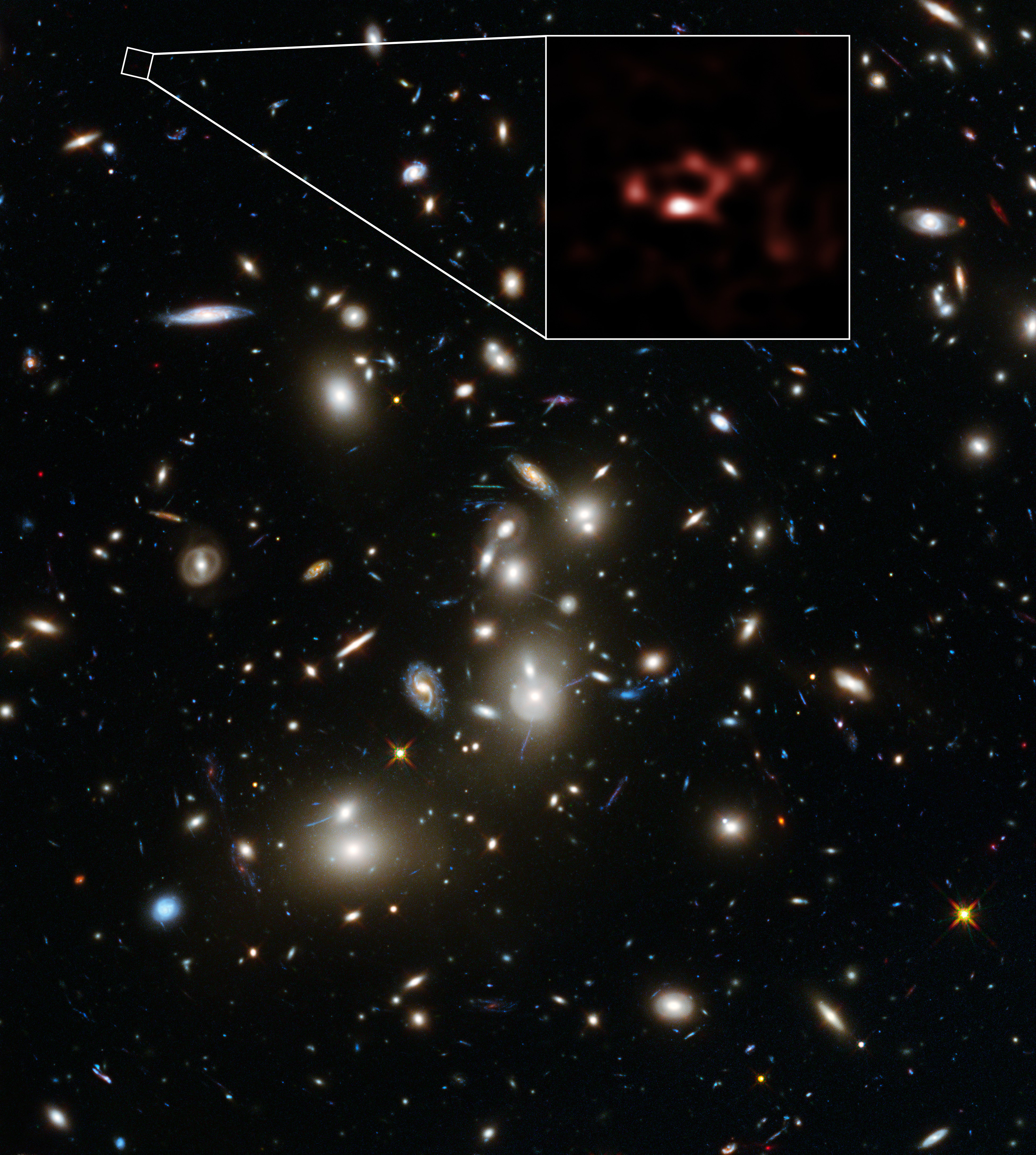
Evolution of galaxies across cosmic time
Galaxies have progressively formed through a complex combination of gas accretion, star formation, and merging with other galactic units. The Formation and Evolution of galaxies research line aims to unveil the physical mechanisms responsible for the most significant transformations in these objects. The team that makes up the research line is surveying the 3D structure of the Milky Way and testing the different scenarios proposed to explain the star formation history of the Universe. IAC will collect an unprecedentedly large sample of superb-quality spectra of distant galaxies with GTC and VLT, and obtain ultra high spatial resolution imaging and 3D spectra of the nearest galaxies with GTCAO+FRIDA to explore the supermassive black hole activity cycle and its influence on galaxy evolution.
The IAC groups study the physics of star formation and the conditions of the interstellar medium in the first galaxies conducting follow-up observations with GTC and the Millimeter Interferometers ALMA, and IRAM of high-z galaxies discovered in the extragalactic surveys with the Herschel Submillimeter Space Observatory and the Spitzer satellite; and narrowband surveys and spectroscopic follow-up of Lyman alpha emitters with the unique capabilities of the OSIRIS and EMIR optical and infrared spectrographs on GTC. They use the nearby galaxies, as probes for the early Universe.
Finally, the recently created theoretical/simulation group aims at linking observations and theory. This group, together with the international collaborations of its members, are performing simulations of galaxy formation and evolution in order to strengthen the interpretation of observational data and provide predictions for future observations.
Specific goals: 
- Measure the 3D structure of the Milky Way and resolve stellar populations in its Globular Cluster system, its satellite galaxies and in nearby galaxies to constrain models of galaxy formation in cosmological scenarios.
- Study the physics of star formation and the conditions of the interstellar medium over the history of the Universe and decipher the role of merging, accretion and supermassive black holes in the centers of galaxies.
Specific Scientific Outputs:
The nuclei of galaxies:
- Review paper on active galactic nuclei (AGN) obscuration in galaxies (Ramos-Almeida & Ricci 2017, Nature Astronomy) and first detection, using the Atacama Large Millimeter Array (ALMA), of the dusty torus around an AGN (García-Burillo et al. 2016, ApJ Letters).
- M87 jet showed a core energy output 2-3 orders of magnitude more powerful than previously found (Prieto et al. 2016).
- Discovery of massive star formation quenching induced by non-thermal effects in the nucleus of the highly star-forming galaxy NGC1097 (Tabatabaei et al. 2018, Nature Astronomy).
- Images obtained with the infrared camera CIRCE installed in the GTC allow us to reveal the morphology of the host galaxy of a powerful AGN. The study shows for the first time that the host galaxy of one of these active "Narrow Line Seyfert 1" galactic nuclei is an elliptical galaxy (D'Ammando et al. 2017 MNRAS Letters).
Local/Nearby Universe:
- The "ISLAndS" project, which obtained 111 orbits with the Hubble Space Telescope to study a sample of spherical galaxies of M31, has made it possible to obtain the star formation history of these galaxies with a temporal resolution of ~ 1 Gigayear at old ages (Monelli et al. 2016; Skillman et al. 2017).
- A scientific team led by the IAC found a precise way to measure the rate of star formation in galaxies using the range of radio frequencies between 1 and 10 GHz (Tabatabaei et al. 2017, ApJ).
- Measured the orbital motions of practically all dwarf galaxy satellites around the Milky Way (Fritz et al. 2018) and search for new satellites of the Large Magellanic Cloud (Fritz et al. 2019).
- Uncovering the birth of the Milky Way through accurate stellar ages with Gaia data (Gallart et al. 2019, Nature Astronomy).
- 3D spectroscopy international collaborations (e.g. CALIFA, MaNGA, MUSE) described the stellar kinematics (Falcón-Barroso et al. 2017) and the relationship between star formation rate and gas-phase metallicity of nearby galaxies (Menguiano et al. 2018, 2019).
- Showed the relic nature of the compact galaxy NGC1277 based on the color distribution of its globular clusters (Beasley et al. 2016, Nature).
- Two new methods have been developed based on the properties of the RR Lyrae variable stars to used them as probes of the first star formation events in galaxies and to study the early formation history of the Milky Way stellar halos (Martínez-Vázquez et al., 2016; Fiorentino et al. 2017).
- Deep spectroscopic observations of the galaxy group Abell 2151, made with AF2/WYFFOS at the WHT, allowed the identification of 360 galaxy members of the cluster (Agulli et al. 2017 MNRAS).
- New stellar population models based on empirical stellar libraries have been published covering the wavelength range from 0.16 to 50 microns (Vazdekis et al., 2016).
Distant Universe:

- Observed with ALMA interstellar dust in one of the most distant galaxies known (Laporte et al. 2017, ApJ Letters).
- Discovery of a very large molecular cold gas disk in a galaxy of a proto-cluster at z~2 (Dannerbauer et al. 2017).
- Detection with ALMA of starburst galaxies at z~4 (Oteo et al. 2016, 2018).
- Micro-lensing studies concluded that gravitational waves detected by the LIGO experiment came from black holes generated in the collapse of stars and not in primordial black holes in the early universe (Mediavilla et al. 2017, ApJ Letters).
- An international team led by IAC researchers has discovered one of the brightest distant non-active galaxies so far known. The discovery of BG1429+1202, 11.4 billion light-years away, has been possible thanks to the effect of gravitational lens produced by a massive elliptical galaxy in the line of sight to the object (Marques-Chaves et al. 2017 ApJL).
- A statistical correlation has been found between the size of the spiral galaxies' bulb and the number of "tidal dwarf" satellite galaxies, remnants of the interaction between host galaxies (López-Corredoira & Kroupa 2016, ApJ).
- An international scientific team in which the IAC participates has discovered that the largest galaxies in the universe are developing in cosmic clouds of cold gas (Emonts et al. 2016, Science).
Faint and Dark Universe:
- Obtained with GTC the deepest image of a galaxy from the ground (Trujillo & Fliri 2016, ApJ). The image is ten times deeper than any other made with ground-based telescopes and allowed the detection of the faint stellar halo, which supports the presently accepted model of galaxy formation.
- Photometric and spectroscopic characterization of the stellar and dark matter content of Ultra-Diffuse Galaxies (Di Cintio et al. 2017; Beasley et al. 2016; Trujillo et al. 2019; Ruíz-Lara et al. 2018).
- A new Einstein ring discovered and its physical properties analysed with the OSIRIS spectrograph at GTC (Bettinelli et al. 2016, MNRAS Letters).
- IAC scientists have participated in the study of a "tadpole" galaxy observed with the Hubble Space Telescope, whose results reveal how cosmic gas triggers the birth of stars in galaxies. This process, which is very difficult to observe, would thus explain the formation of galaxies like the Milky Way (Elmegreen et al. 2016, ApJ).
Simulating the Universe:
- The EAGLE state-of-the-art cosmological simulation released (McAlpine et al. 2016) and APOSTLE simulating the surroundings of a typical Milky Way galaxy (Sawala et al. 2016) offer a solution to the mysterious missing satellite problem.
- An algorithm developed by the IAC researcher Sebastian Hidalgo to analyze data on star formation in the Universe has been selected to run in the global computing event "Global Azure Bootcamp 2017".



